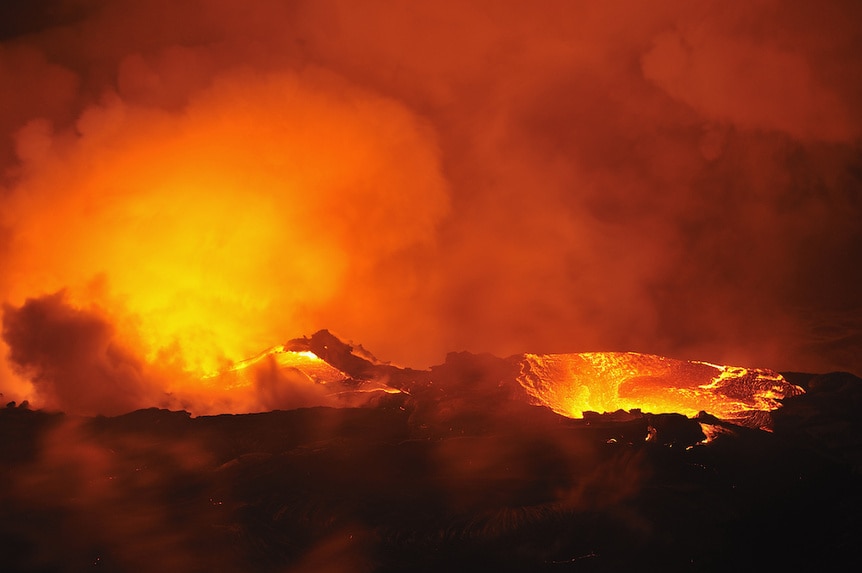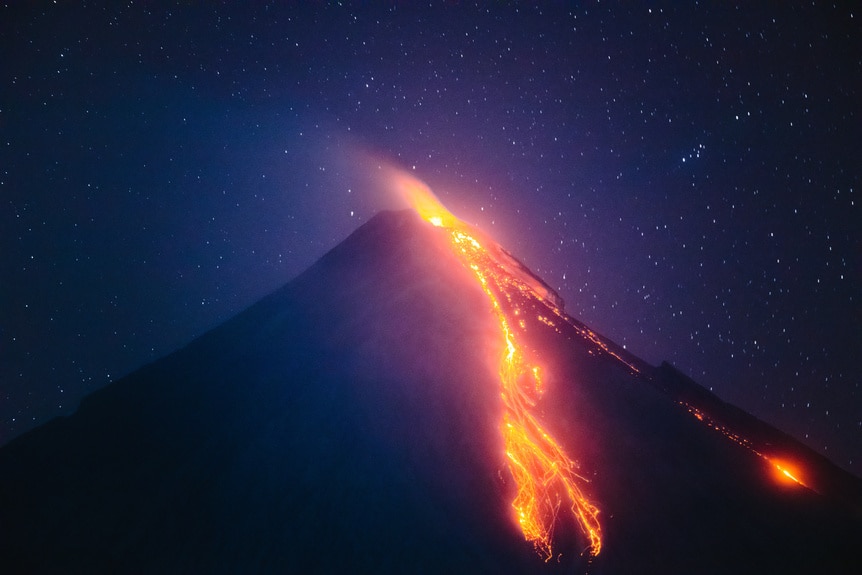Create a free profile to get unlimited access to exclusive videos, sweepstakes, and more!
How Volcanic Eruptions May Have Sparked Life on Earth
Volcanoes destroy, but they also create.

The 1997 disaster flick Dante’s Peak (streaming now on Peacock) follows Harry Dalton (Pierce Brosnan), a volcanologist for the U.S. Geological Survey. Dalton dedicated his life, and risked it, trying to understand the incredible power of our planet’s volcanoes. He’s assigned to investigate potential activity near the fictional town of Dante’s Peak, where a supposedly dormant stratovolcano violently erupts, engulfing the town and anyone still in it.
It’s a cinematic example of the awesome power of our planet, the pure destructive energy it can and sometimes does unleash. But it’s not all chaos and destruction, those same destructive volcanic processes sustain life on our planet and may have sparked life in the first place.
For More on Volcanoes:
Volcano Erupts on Iceland's Reykjanes Peninsula for 5th Time in 3 Years
Giant "Hidden" Volcano Taller Than Everest Discovered on Mars
European Supervolcano Erupts Every 10,000 Years, So How Long Until the Next One?
Volcanic Lightning Might Have Sparked Life on Earth
Volcanoes are ideal furnaces in which to do interesting chemistry, and life is the most interesting type of chemistry there is. They provide plenty of heat, pressure, and material all mixed up in the same place, and that’s precisely what you need to kick off some self-sustaining organisms.
Nitrogen is a key component of amino acids, the building block of proteins, and there’s plenty of it on Earth. Our atmosphere is about 78% nitrogen and only 21% oxygen, the oxygen gets all the attention because it’s useful to us. We breathe in the nitrogen and breathe it right back out again without doing anything with it. Plants, however, need that nitrogen, and they can’t get to it on their own.
Gaseous nitrogen isn’t readily available to plants, so they join forces with nitrogen fixing bacteria, which transform atmospheric nitrogen into nitrates the plants can use. The first life wouldn’t have had any life forms around, though, so it would have needed a non-biological source of nitrates. That source might have been volcanic lightning.
The energy unleashed during a lightning strike produces incredible temperatures, exciting gasses in the atmosphere. The heat is enough to break nitrogen molecules apart into individual nitrogen molecules, which then have an opportunity to combine with oxygen to become nitrates. In a normal lightning strike, only a small amount of nitrates are produced, but around volcanoes things get serious.
The 2022 eruption at Hunga Tonga-Hunga Ha’apai dumped 11 billion pounds of material into the air every second, during its peak, and generated the most intense lightning storm ever recorded. The eruption occurred 65 miles north of Tongatapu, Tonga's main island, beneath the surface of the ocean. The eruption carried gas, dust, but also water vapor into the atmosphere, to an altitude of 36 miles (58 kilometers). The cloud of volcanic debris rose and then spread like a mushroom cap triggering as many as 40 lightning strikes a second during its peak. Volcanic eruptions are natural factories for producing nitrates that organisms can use.
Volcanic Soils Feed the Planet
Once the eruption is over and the dust has settled, the surrounding soils become higher in nutrients. The soils surrounding volcanically active areas are often super fertile, providing better crop yields than non-volcanic soils. Not only are volcanic soils nutrient rich, but they are also more porous and better retain moisture.
That’s why we so often find oases of life surrounding volcanic hotspots. On land, the valleys surrounding volcanoes can be lush and full of life. Underwater, volcanoes and thermal vents provide nutrients and islands of warmth in a cold and dark sea. They’re influence, however, isn’t isolated to the areas directly around them. On long enough timescales, volcanic enrichment gets scattered by wind and water all over the planet.
Meanwhile, volcanoes dumped liquid rock like freshly poured concrete, delivering the raw construction materials for building the continents. The gas and dust accompanying the lava helped to fill the oceans and blanket the planet in an atmosphere. Volcanoes aren’t the sole reason that our planet is such a nice place to hang out, but all signs suggest that without them life as we know it couldn’t have emerged or survived.
Volcanoes are just one type of geological machinery that our planet uses to keep the nutrients and energy in circulation. On balance, they are an objectively good thing for us and for all life on Earth, we just have to hope we’re not standing in the way of one of those volcanoes while it does its good work. If Harry Dalton tells you it’s time to run, listen.
Dante’s Peak is streaming now on Peacock.




























